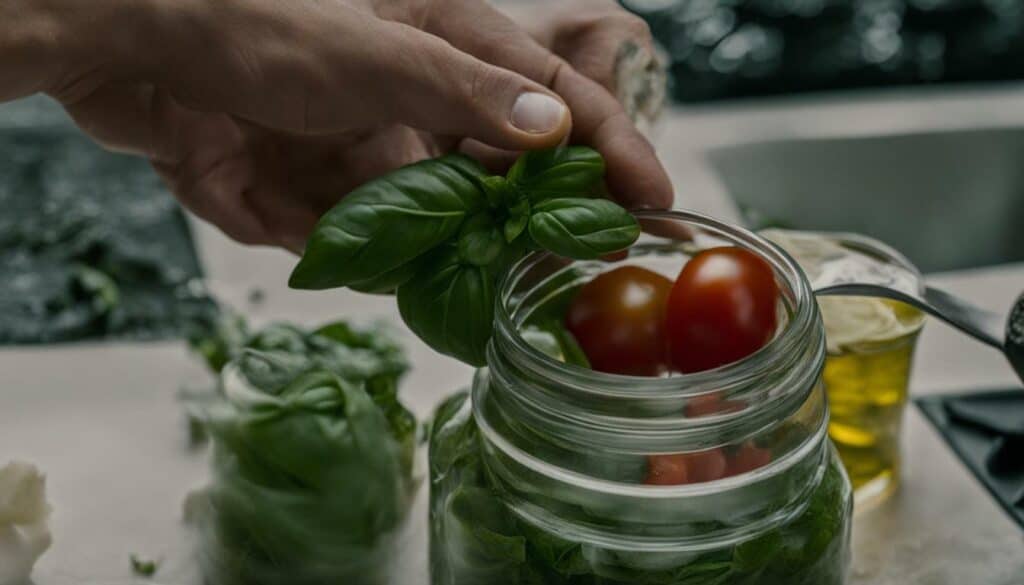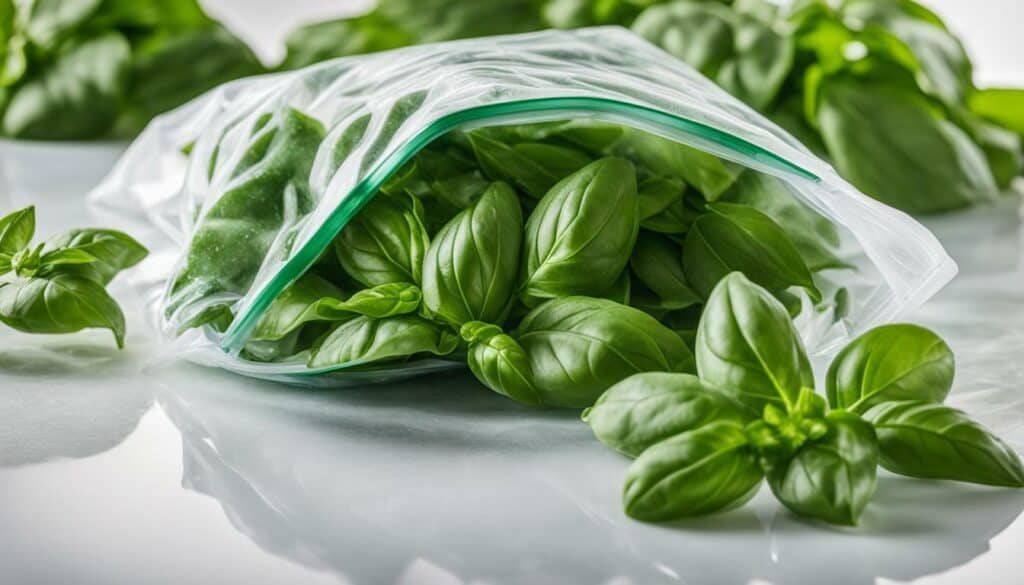Freezing basil is an easy and convenient way to preserve your fresh basil from the garden. Not only does it ensure that you can enjoy its unique flavor and aroma in your favorite dishes all year round, but it also helps to minimize waste and save money. There are several methods you can use to freeze basil easily, each with its unique benefits and drawbacks. In this guide, we’ll take a closer look at some of the most popular methods to help you choose the best one for your needs.
Key Takeaways:
- Freezing basil is an effective way to preserve its vibrant flavor for use in your favorite recipes.
- There are several methods for freezing basil, including freezing whole leaves, freezing in oil, and blanching and freezing.
- Each method has its unique benefits and drawbacks, so choose the one that suits your needs best.
Methods for Freezing Basil
There are several methods you can use to freeze basil from the garden, each with its own benefits and drawbacks. Two popular and effective methods include freezing whole basil leaves and freezing basil in oil.
To freeze whole basil leaves, start by cleaning and drying the basil. Once dry, lay the leaves in a single layer on a baking sheet and place in the freezer until the leaves are hardened. Once frozen, transfer the leaves to an airtight freezer bag. This method is perfect for those who want to preserve the basil for later use in soups, stews, and other dishes that require cooked basil.
Another popular method for freezing basil is to freeze it in oil. To do this, thinly slice the basil and divide it into a silicone ice cube tray. Drizzle a little olive oil over each batch of basil and push the leaves down into the oil to coat them. Freeze until hardened, then transfer the cubes to an airtight freezer bag. This method is perfect for those who want to preserve the fresh flavor and aroma of the basil for use in salads, marinades, and other uncooked dishes.
Regardless of which method you choose, freezing basil is a great way to preserve its flavor and use it in various recipes throughout the year. So, whether you’re looking to make a batch of pesto or add some fresh basil to your favorite soup recipe, freezing basil from the garden is a simple and effective solution.

Blanching Basil Leaves
One popular method for freezing basil involves blanching the basil leaves in boiling water, which helps to maintain their bright green color and lock in their flavors. To begin, wash and dry your basil leaves thoroughly.
Next, bring a pot of water to a boil and prepare an ice bath by filling a bowl with cold water and ice cubes. Once the water is boiling, dip the basil leaves into the pot for a few seconds, then transfer them immediately to the ice bath to cool. This process will help to stop the cooking and preserve the color and flavor of the basil leaves.
Once the basil leaves are completely dry, they can be frozen in a single layer on a baking sheet or tray. After they are frozen, transfer them to an airtight bag or container and store them in the freezer until you’re ready to use them.
An alternative method for freezing basil involves freezing the leaves in oil. To do this, thinly slice the basil leaves and place them in a silicone ice cube tray. Drizzle olive oil over the basil and freeze until hardened. Once the cubes are frozen, remove them from the tray and store them in a freezer bag for easy access. When you’re ready to use the frozen basil, simply remove the desired amount from the freezer and add it to your recipes.
By blanching and freezing basil, you can enjoy the fresh flavor and aroma of your garden basil all year long. This method is ideal for preserving basil color and locking in the flavor of your favorite herb.

Freezing Whole Basil Leaves on a Tray
Freezing whole basil leaves on a tray is a convenient and easy way to preserve fresh basil for year-round use. Once the basil leaves are blanched and dried, you can freeze them in a single layer on a baking sheet or tray. This method is perfect for preserving the shape and texture of the leaves, and it allows you to easily remove the desired amount of basil whenever needed.
To freeze basil leaves, start by boiling a pot of water and preparing an ice bath. Blanch the basil leaves in the boiling water for 30 seconds, then immediately transfer them to the ice bath to preserve their green color. After drying the basil leaves, place them in a single layer on a baking sheet or tray. Make sure the leaves are not touching each other to prevent them from sticking together. Cover the tray with plastic wrap or aluminum foil and place it in the freezer.
Once the basil leaves are frozen, remove them from the tray and transfer them to a freezer bag or container. Label the bag or container with the date and freeze for up to six months.

When using frozen basil leaves, simply remove the desired amount from the bag or container and add them to your recipe. Frozen basil leaves can be used to make pesto, soups, stews, and more. The flavor of the basil will be just as fresh as when it was first harvested from the garden.
Freezing Basil in Oil Using an Ice Cube Tray
Another method for freezing basil involves slicing the blanched and dried leaves and freezing them in oil using a silicone ice cube tray. This is a simple and convenient way to preserve fresh basil, as it allows you to defrost individual portions of basil without having to thaw an entire batch.
To begin, wash and dry the basil leaves, then thinly slice them into small pieces. Fill each compartment of a silicone ice cube tray with the sliced basil, making sure not to overfill them. Drizzle a small amount of olive oil over the basil in each compartment, ensuring that each slice is coated.
| Steps to Freeze Basil in Oil Using an Ice Cube Tray: |
|---|
| 1. Wash and dry the basil leaves. |
| 2. Thinly slice the basil leaves into small pieces. |
| 3. Fill each compartment of a silicone ice cube tray with the sliced basil. |
| 4. Drizzle a small amount of olive oil over the basil in each compartment, ensuring that each slice is coated. |
| 5. Freeze the tray until the basil and oil are hardened. |
| 6. Remove the cubes from the tray and transfer them to an airtight freezer bag. |
Place the ice cube tray in the freezer and leave it until the basil and oil are fully frozen, which should take around 2-4 hours. Once frozen, remove the tray from the freezer and pop the basil cubes out of the compartments. Transfer the cubes to an airtight freezer bag, removing any excess air before sealing it shut.
These frozen basil cubes can be used in a variety of dishes throughout the year, including sauces, soups, stews, and more. The flavor and color of the basil are retained through this method, so you can enjoy the delicious taste of fresh basil all year round.

Freezing basil in oil is a great method for preserving fresh basil, and it’s easy to do using a silicone ice cube tray. Another option for freezing basil is to freeze whole leaves on a tray, which prevents them from sticking together and allows you to easily grab a single leaf whenever you need it. Whatever method you choose, freezing basil is a great way to prolong the life of this delicious herb and enjoy its flavor even when it’s not in season.
Rolling and Freezing Basil Leaves
An alternative method for freezing basil is to roll the blanched and dried leaves into a cigar-like shape and place them in a sealed bag or container. This method is perfect for those who want to store basil in smaller portions or have limited freezer space.
To start, blanch the basil leaves by dipping them into boiling water for 2-3 seconds and immediately transferring them to an ice bath. This process helps to preserve the bright green color of the leaves. Once blanched, dry the basil leaves by gently patting them with a paper towel.
Next, place the leaves in a single layer on a sheet of wax paper or parchment paper. Roll the leaves tightly, forming a cigar-like shape. Place the rolled basil in a sealed bag or container, removing as much air as possible to prevent freezer burn. Label the bag or container with the date and contents before placing it in the freezer.
When you’re ready to use the frozen basil, simply remove the desired amount from the container and chop it up. Alternatively, you can thaw the entire roll and slice off what you need.

Rolling and freezing basil leaves is a great way to preserve the herb’s fresh flavor and vibrant color for use in various recipes throughout the year. By using this method, you can ensure that your basil stays fresh and flavorful, even during times when it’s not in season.
Benefits of Freezing Basil
Freezing basil allows you to prolong the life of your garden-fresh basil. Instead of letting it go to waste, freezing basil enables you to enjoy the fresh flavor throughout the year. Compared to drying basil, freezing locks in the herb’s flavors more effectively and maintains freshness for longer.
There are a variety of ways to freeze basil, with the two main methods being freezing whole basil leaves and freezing basil in oil. Freezing whole basil leaves is a simple process that involves cleaning and drying the leaves before spreading them out in a single layer on a baking sheet and freezing. This method prevents the leaves from sticking together, making it easy to grab a single leaf when needed. Frozen basil leaves can be used in various recipes, including marinara sauces, syrups, granitas, and sorbets.
The second method involves freezing the basil leaves in oil. The leaves are thinly sliced and placed in a silicone ice cube tray, with olive oil drizzled over the basil. The tray is then placed in the freezer until the oil and basil harden. The frozen basil cubes can be stored in an airtight freezer bag and added directly to sauces or soups while cooking.
Both methods are easy and effective ways to preserve basil for later use. Freezing basil allows you to enjoy the fresh flavor of basil all year round without the effort of making pesto or the need to process the herb further. By freezing garden-fresh basil, you can extend the life of your herb and enjoy its delicious flavor in various recipes.
Using Frozen Basil in Recipes
Frozen basil can be easily incorporated into a wide range of recipes, adding a burst of freshness to your dishes. Whether you’re making pasta sauces, soups, or salad dressings, frozen basil is a convenient way to enjoy the flavors of this herb year-round. Here are some ideas and tips for cooking with frozen basil:
- Pesto: Use frozen basil to make delicious and aromatic pesto. Simply blend frozen basil leaves with garlic, Parmesan cheese, pine nuts, and olive oil in a food processor until smooth. Add salt and pepper to taste. Serve over pasta, grilled chicken, or vegetables.
- Tomato sauce: Add frozen basil to your favorite tomato sauce recipe for an extra burst of freshness. Simply thaw the frozen basil and stir it into the sauce at the end of cooking.
- Salad dressing: Make a flavorful vinaigrette by blending frozen basil with olive oil, red wine vinegar, Dijon mustard, honey, and salt and pepper to taste. Use it as a dressing for your favorite salad.
- Herbed butter: Mix thawed frozen basil with softened butter and spread it on fresh bread, grilled corn on the cob, or steamed vegetables.
Remember that frozen basil can be slightly less flavorful than fresh basil, so make sure to add enough to achieve the desired taste. It is recommended to use frozen basil within three months for the best quality.

Storing Frozen Basil
Proper storage is essential to preserve the flavor of frozen basil. To ensure that your frozen basil retains its freshness, follow these tips:
- Use airtight containers or freezer bags to keep out moisture and air.
- Label your containers with the freezing date to keep track of how long the basil has been frozen.
- Store your frozen basil at 0°F (-18°C) or below to maintain its quality.
If stored correctly, frozen basil can last for up to 8 months in the freezer. When preparing to use your frozen basil, remove only the amount you need and return the remaining portions to the freezer immediately. Avoid thawing and refreezing your basil to maintain its texture and flavor.

Freezing basil from your garden is an easy and convenient way to preserve its flavor for year-round use. By using the proper storage techniques, your frozen basil will retain its freshness and bring a burst of flavor to your favorite dishes.
Is It Better to Freeze or Dry Basil from the Garden?
When it comes to preserving the flavor of your garden-fresh basil, you might wonder whether it’s better to freeze or dry basil from your garden. Freezing basil can help retain its vibrant color and taste, making it a great choice for dishes like pesto. On the other hand, drying basil from your garden allows you to have dried herbs readily available for seasoning soups, stews, or sauces. Ultimately, the choice between freezing and drying depends on your personal preferences and the intended use of the basil.
Conclusion
Freezing basil is a simple and effective way to preserve the freshness of your garden basil throughout the year. You don’t have to worry about disposing of extra basil during harvest season, as you can easily freeze it and enjoy its fresh flavor all year long. Among the various methods available, freezing basil leaves without blanching proves to be the easiest and most effective way to preserve their vibrant green color.
One of the significant advantages of freezing basil is the convenience it offers when using small portions during cooking. Frozen basil leaves can be used in various recipes such as pasta sauces, salad dressings, and pesto. It’s an excellent way to enjoy the refreshing taste of basil in your favorite dishes without having to buy fresh basil frequently.
Overall, freezing basil is a practical and straightforward technique that ensures the availability of fresh basil all year long. Whether you are an experienced home cook or a beginner, you can quickly freeze your garden fresh basil without worrying about loss of flavor or nutrients. Try the different methods discussed in this article and choose the best one that suits your cooking style and preferences. Happy freezing!
FAQ
Q: Can I freeze basil from the garden?
A: Yes, freezing basil is an easy and convenient way to preserve your fresh basil from the garden.
Q: What are the methods for freezing basil?
A: There are several methods you can use, including blanching, freezing in oil, and rolling and freezing.
Q: How do I blanch basil leaves?
A: To blanch basil leaves, immerse them in boiling water for a few seconds, then transfer them to an ice bath to preserve their green color.
Q: How do I freeze whole basil leaves on a tray?
A: After blanching and drying the basil leaves, you can freeze them in a single layer on a baking sheet or tray.
Q: How do I freeze basil in oil using an ice cube tray?
A: Slice the blanched and dried basil leaves and freeze them in oil using a silicone ice cube tray for individual portions.
Q: How do I roll and freeze basil leaves?
A: Roll the blanched and dried basil leaves into a cigar-like shape and freeze them in a sealed bag or container.
Q: What are the benefits of freezing basil?
A: Freezing basil extends its shelf life and allows you to enjoy the fresh flavor of basil from your garden throughout the year.
Q: How can I use frozen basil in recipes?
A: Frozen basil can be used in various recipes, adding flavor to soups, sauces, pestos, and more.
Q: How should I store frozen basil?
A: Store frozen basil properly in airtight containers or bags to ensure its flavor and quality are preserved.
Source Links
- https://champagne-tastes.com/how-to-freeze-basil/
- https://anoregoncottage.com/freezing-basil-leaves-6-ways/
- https://www.platingsandpairings.com/how-to-freeze-basil/
- https://www.thespruceeats.com/how-to-freeze-basil-1388437
- https://savvygardening.com/how-to-freeze-basil/
- https://homesteadingfamily.com/how-to-freeze-basil/
- https://www.thespruceeats.com/the-best-ways-to-preserve-basil-1327671
- https://www.fueledwithfood.com/how-to-freeze-basil/
- https://asimplepalate.com/blog/how-to-freeze-basil-basil-cubes/
- https://momcrieff.com/how-to-freeze-basil-with-oil-and-in-an-ice-cube-tray/
- https://www.goodlifeeats.com/how-to-freeze-basil-recipes-to-use-frozen-basil/
- https://www.wikihow.com/Freeze-Basil





Leave a Reply